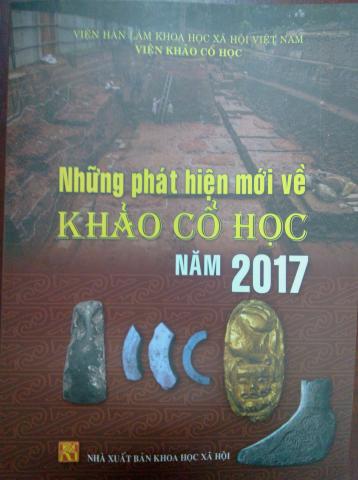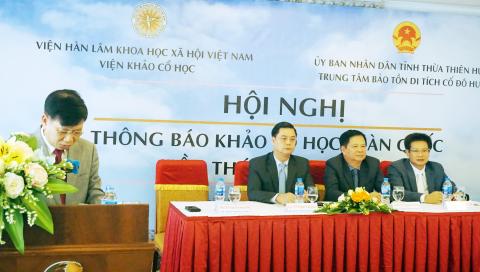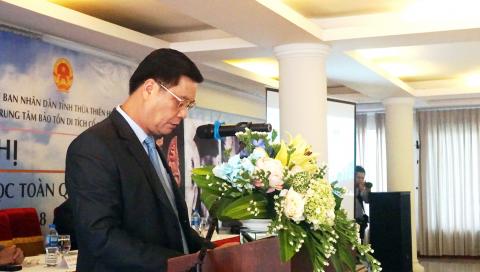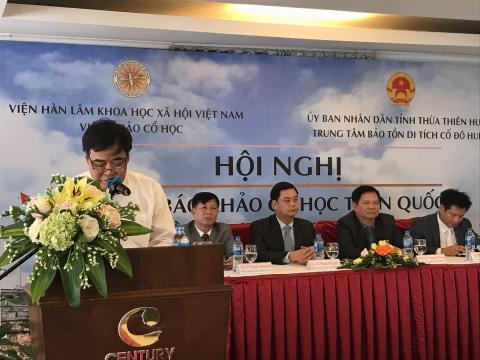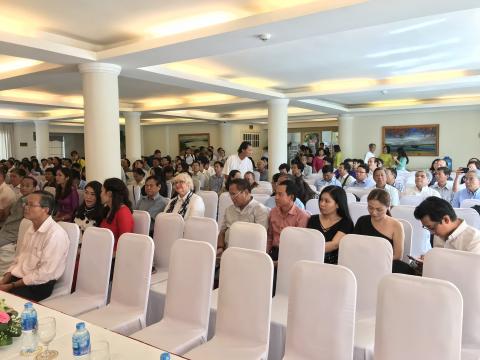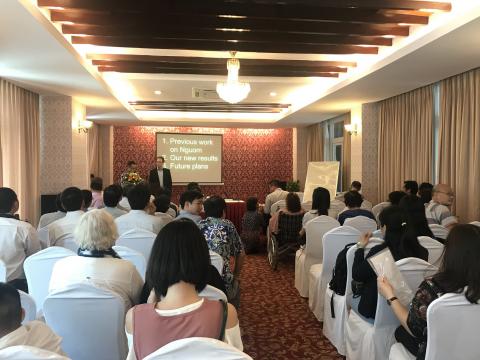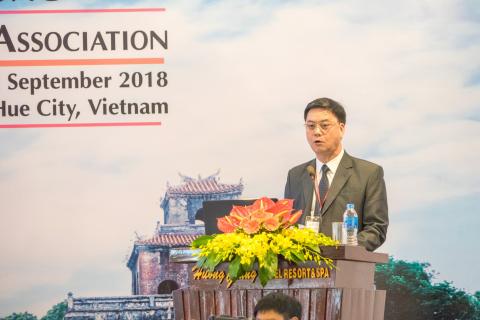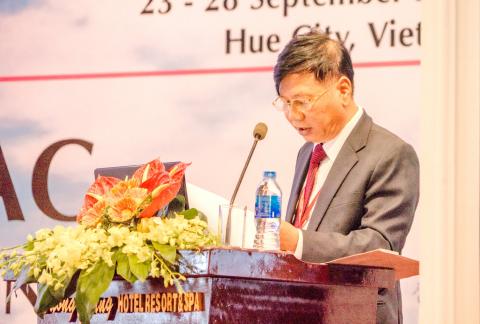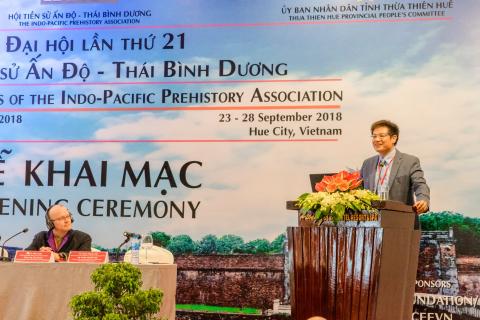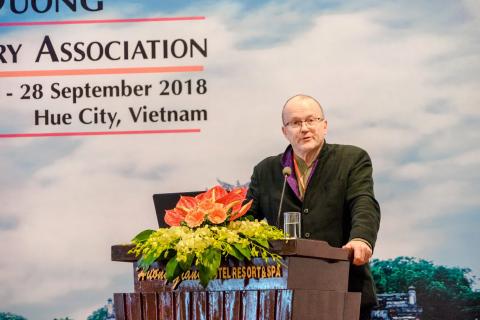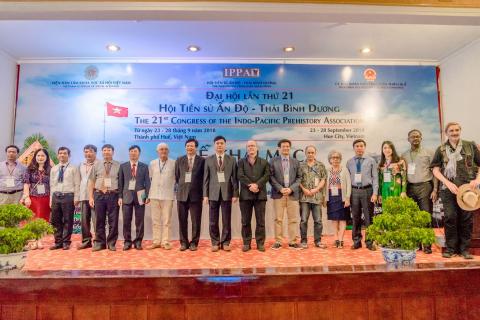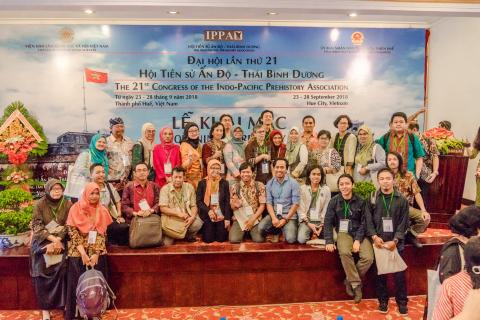Nội dung cuốn sách tập hợp 305 bài viết của các tác giả khác nhau ở các cơ quan khác nhau như các bảo tàng, sở Văn hóa, Viện nghiên cứu, trung tâm bảo tồn di tích .v.v. , các cá nhân trong cả nước về những tổng kết, đánh giá và thông báo những phát hiện mới về khảo cổ học trong năm 2017.
Xin trân trọng giới thiệu đến đông đảo các nhà nghiên cứu và những ai quan tâm.
Xin trân trọng giới thiệu!
Viện Hàn lâm khoa học xã hội Việt Nam
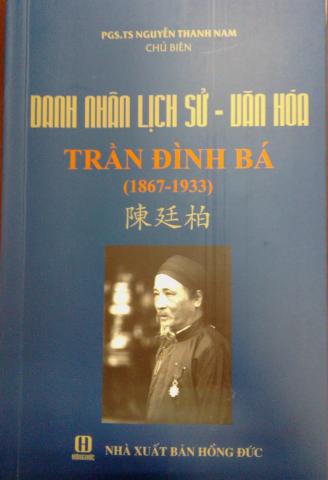 .TS Nguyễn Thanh Nam (Chủ biên)
.TS Nguyễn Thanh Nam (Chủ biên)- Nxb: Hồng Đức - 2018
- Khổ sách: 16 x 24cm
- Số trang: 303 trang
Nội dung cuốn sách: Cuốn sách viết về cuộc đời, con người, sự nghiệp của danh nhân lịch sử văn hóa Trần Đình Bá. Ông sinh năm Đinh Mão (tức 1867) dưới thời vua Tự Đức, có hiệu là Phước Trang, tự Tân Phủ. Ông là người ấp Phước Tự, thôn Hiền Lương, tổng Hiền Lương, huyện Phong Điền, phủ Thừa Thiên (nay là thôn Hiền Lương, xã Phong Hiền, huyện Phong Điền, tỉnh Thừa Thiên Huế). Ông nội của Trần Đình Bá là cụ Trần Văn Đắc làm võ quan, trật Tòng Thất phẩm, chức Tinh binh Đội trưởng thuộc Bộ Công dưới triều Tự Đức. Năm 1897 (Đinh Dậu) dưới thời vua Thành Thái, Trần Đình Bá dự thi Hương, đỗ cử nhân. Năm sau, 1898 (Mậu Tuất) ông dự thi Hội và đỗ Phó Bảng. Ông mất năm 1933, hưởng thọ 67 tuổi.
Sách gồm 2 phần: 1/Trần Đình Bá - Quê hương, thân thế và sự nghiệp; 2/Những đánh giá khách quan và di sản vật thể còn lại, tập hợp những bài viết khác nhau của nhiều tác giả khác nhau
Xin trân trọng giới thiệu!
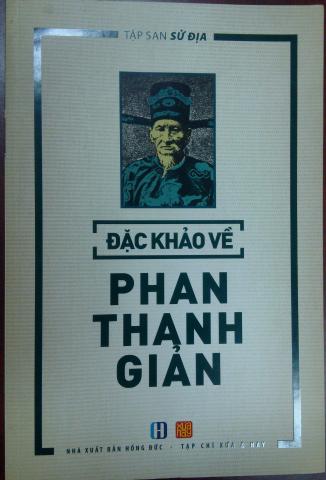 Nguyễn Thế Anh, Bửu Cầm, Phan Khoang và nhiều tác giả khác.
Nguyễn Thế Anh, Bửu Cầm, Phan Khoang và nhiều tác giả khác.- Nxb: Hồng Đức - 2016
- Khổ sách: 16 x 24cm
- Số trang: 255 trang
Tạp chí Xưa và Nay đã phối hợp với Nhà xuất bản Hồng Đức xuất bản số đặc khảo “Đặc khảo về Phan Thanh Giản” với mục đích ghi nhận lại những đóng góp, dấu ấn một thời hoạt động sôi nổi của một số sinh viên, trí thức Sài Gòn; đồng thời cung cấp tài liệu tham khảo bổ ích cho các nhà khoa học đang quan tâm nghiên cứu về lịch sử, địa lý, văn hóa Việt Nam.
Nội dung cuốn sách viết về con người, cuộc đời hoạt động của Phan Thanh Giản với nhiều bài viết khác nhau của các tác giả khác nhau.
1/ Phan Thanh Giản đi sứ ở Paris; 2/ Phan Thanh Giản dưới mắt người Pháp qua vài tài liệu; 3/Một nghi vấn về tập Tây Phù Nhật ký; 4/ Kinh lược đại thần Phan Thanh Giản với sự chiếm cứ ba tỉnh miền Tây; 5/ Chung quanh cái chết và trách nhiệm của Phan Thanh Giản trước các biến cố của Nam Kỳ cuối thế kỷ XIX; 6/ Cuộc đời Phan Thanh Giản; 7/ Cuộc đời hoạt động của Phan Thanh Giản; 8/ Nhân cuộc du xuân may gặp kho tàng quý giá về cụ Phan Thanh Giản; 9/ Thái độ của triều đình Huế đối với Phan Thanh Giản từ vua Tự Đức đến vua Đồng Khánh. Và một số các tác phẩm được dịch.
Xin trân trọng giới thiệu!
|
Chiều 29-9, tại TP Huế (Thừa Thiên - Huế), Viện Khảo cổ học - Viện Hàn lâm Khoa học xã hội Việt Nam phối hợp với Trung tâm Bảo tồn di tích cố đô Huế tiến hành khai mạc Hội nghị thông báo Khảo cổ học toàn quốc lần thứ 53 - năm 2018. |
|
Đến dự hội nghị có các lãnh đạo UBND tỉnh Thừa Thiên - Huế; Viện Hàn lâm Khoa học xã hội Việt Nam, Viện Khảo cổ học cùng đông đảo các nhà nghiên cứu khoa học, đại diện lãnh đạo các bảo tàng trong toàn quốc. Theo tổng kết của PGS.TS Bùi Văn Liêm, Hội nghị năm nay đã nhận được trên 356 bài viết theo các chủ đề của 4 tiểu ban: Khảo cổ học tiền sử, Khảo cổ học lịch sử, Khảo cổ học Champa – Óc Eo, Khảo cổ học dưới nước. Đây là những phát hiện mới về di tích, di vật cũng như những nghiên cứu chuyên sâu xuyên suốt từ thời tiền sử đến lịch sử. Phát biểu khai mạc hội nghị, GS.TS Phạm Văn Đức, Phó Chủ tịch Viện Hàn lâm Khoa học xã hội Việt Nam khẳng định: Hội nghị lần này là diễn đàn khoa học để các nhà khoa học chia sẻ các kết quả nghiên cứu, đồng thời là cơ hội để các nhà khoa học, nhất là nhà khoa học trẻ tiếp cận, học hỏi các thế hệ đi trước nhằm hoàn thiện năng lực nghiên cứu khoa học của mình.
Tại hội nghị lần này, nhiều phát hiện về khảo cổ học được công bố như: kết quả khai quật khảo cổ học tại di tích sơ kỳ Đá cũ ở thị xã An Khê (tỉnh Gia Lai); phát hiện mũi khoan đá ở Hoa Lộc; những kết quả phân tích của chương trình hợp tác ADN trong khảo cổ học giữa Việt Nam và Đan Mạch; phát hiện hang động núi lửa ở Tây Nguyên có con người cư trú…
Sau phiên khai mạc, các nhà khoa học đã trình bày và thảo luận tại các phòng họp tiểu ban. Hội nghị sẽ diễn ra trong hai ngày 29-30/9. 16h30-17h chiều 30/9, Hội nghị sẽ bế mạc. |
| Tin, ảnh: Nguyễn Thơ Đình |
Sáng ngày 23.9.2018, hơn 500 nhà nghiên cứu và sinh viên sau đại học từ 35 quốc gia trên thế giới, trong đó có Việt Nam đã đến tham dự phiên Khai mạc Đại hội lần thứ 21 của Hội tiền sử Ấn Độ-Thái Bình Dương tại Khách sạn Hương Giang, thành phố Huế.
Chủ trì phiên Khai mạc, về phía Viện Hàn lâm Khoa học xã hội Việt Nam có GS.TS Phạm Văn Đức (Phó Chủ tịch), PGS.TS Nguyễn Giang Hải (Viện trưởng Viện Khảo cổ học); Về phía tỉnh Thừa Thiên Huế có PGS.TS Nguyễn Dung (Phó Chủ tịch UBND tỉnh), TS. Phan Thanh Hải, Giám đốc Trung tâm Bảo tồn Di tích Cố đô Huế; GS.TS. Ian Lilley (Tổng Thư ký Hội tiền sử Ấn Độ - Thái Bình Dương).
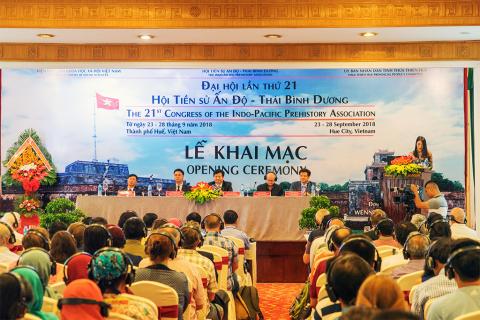
Khai mạc Đại hội lần thứ 21 IPPA
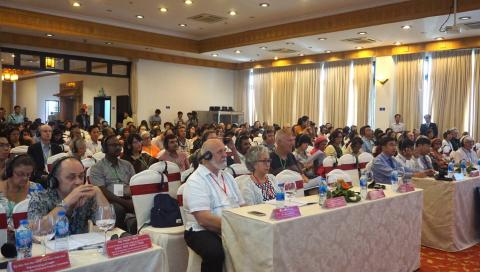
Toàn cảnh phiên Khai mạc
Sau phát biểu khai mạc và chào mừng của GS.TS. Phạm Văn Đức và PGS.TS Nguyễn Dung, Đại hội đã nghe 2 tham luận của PGS.TS Nguyễn Giang Hải: “Những nghiên cứu gần đây của Khảo cổ học Việt Nam” và TS. Phan Thanh Hải với tham luận “Di sản văn hóa Huế và công tác bảo tồn”.
Một số hình ảnh các đại biểu với phiên Khai mạc:
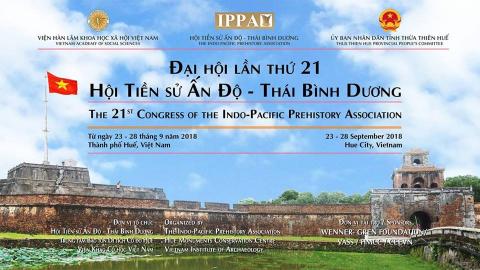
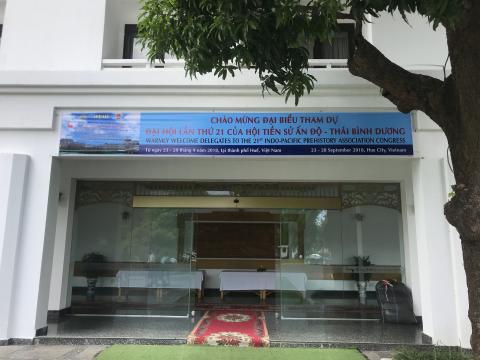
Khách sạn Hương Giang thành phố Huế, nơi diễn ra Đại hội IPPA
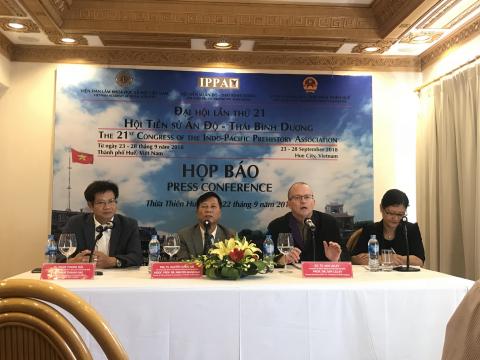
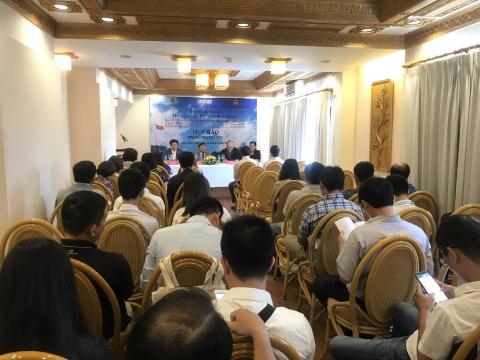
Thông cáo báo chí về Đại hội lần thứ 21 của Hội Tiền sử Ấn Độ - Thái Bình Dương (IPPA)
Hội nghị với nhiều chủ đề tham luận khác nhau với nhiều phương pháp lý thuyết mới và kỹ thuật cao trong nghiên cứu thực địa và phòng thí nghiệm về khảo cổ học Tiền sử, bảo tồn di sản văn hoá...
Vào ngày 23/9 sẽ diễn ra phiên khai mạc chính thức của Đại hội. Kết thúc các bài tham luận tại phiên khai mạc, các đại biểu sẽ trình bày và thảo luận tại 6 phòng họp (3 phòng tại khách sạn Hương Giang, 3 phòng tại khách sạn Century).
Các đại biểu sẽ trình bày tham luận tại các tiểu ban từ 23-25/9. Ngày 26/9 các đại biểu đi tham quan các di tích tại Cố đô Huế. Các phiên tham luận tiếp tục vào ngày 27-28/9.
Theo đó Viện Khảo cổ học thực hiện các quyền tự chủ về tài chính; về thực hiện nhiệm vụ; về tổ chức bộ máy, nhân sự; về quản lý và sử dụng tài sản theo quy định tại Nghị định số 54/2010/NĐ-CP ngày 14/6/2016 của Thủ tướng Chính phủ quy định cơ chế tự chủ của tổ chức khoa học và công nghệ công lập.
Chi tiết xin xem file Quyết định đính kèm.
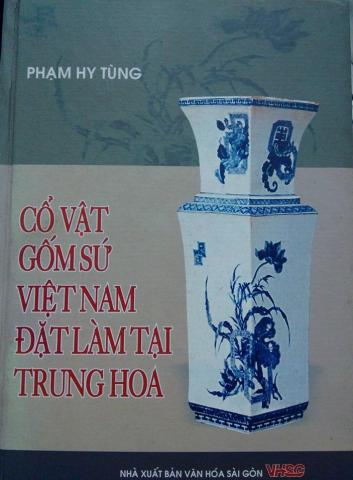 m Hy Tùng
m Hy Tùng- Nxb: Văn hóa Sài Gòn – 2006
- Khổ sách: 14,5x 20,5cm
- Số trang: 384 trang

